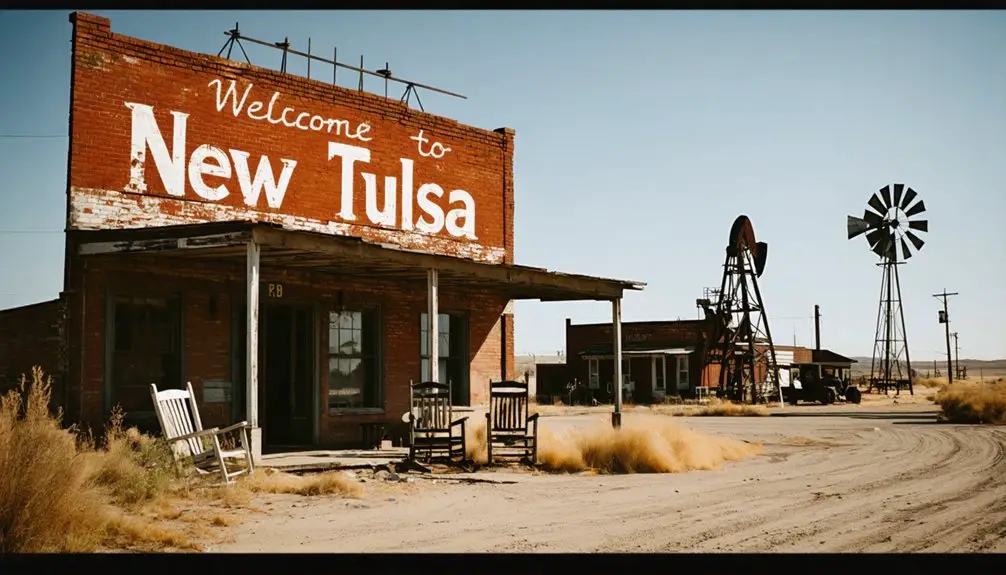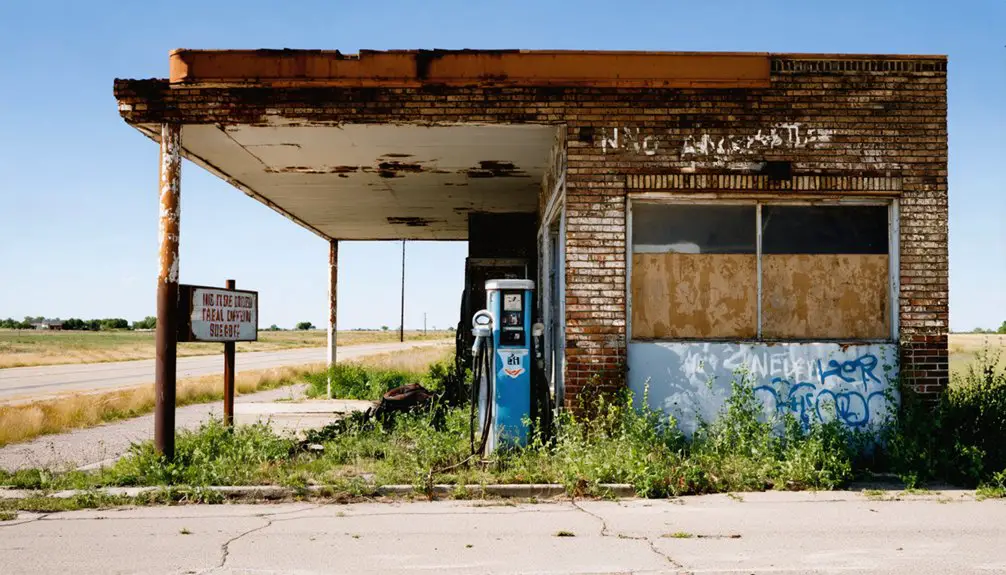You’ll find New Tulsa’s ghost town five miles east of the Tulsa-Wagoner county line, where it operated as an incorporated town from 1967 to 2001. Originally called Oak Grove, it renamed itself to resist annexation under Cal Tinney’s leadership. The town grew from just 17 residents in 1970 to 568 by 2000, but struggled with administrative challenges before citizens voted to dissolve and merge with Broken Arrow. Its abandoned structures tell a compelling story of Oklahoma’s evolving landscape.
Key Takeaways
- New Tulsa was established in 1966 as Oak Grove and renamed to resist annexation, eventually becoming a ghost town in Oklahoma.
- The town grew from 17 residents in 1970 to 568 by 2000, before dissolving in 2001 through a citizen vote.
- Key institutions included a church, school, and general store, with the store’s 1975 closure marking the beginning of decline.
- Administrative challenges, unused municipal funds, and over 15,000 annual blight complaints contributed to the town’s downfall.
- The area is now part of unincorporated Wagoner County, with few remaining structures from the original settlement.
The Rise and Fall of a Small Town
While many ghost towns emerge from economic busts, New Tulsa‘s story reflects a different path to dissolution, marked by administrative challenges and stunted growth.
You’ll find a community that began as Oak Grove in 1966, quickly renaming itself New Tulsa to avoid annexation by neighboring cities. The rural identity centered around a general store that served as the town’s heartbeat from 1946 to 1975. Led by Cal Tinney’s incorporation, the town established its independence and charted its own course.
Despite initial hopes, community dynamics remained stagnant. The population crawled from just 17 residents in 1970 to 568 by 2000. The area shares similarities with modern Tulsa’s own dark history, including the tragic events of the 1921 Race Massacre.
Though the town collected gas-tax revenues, municipal activity nearly ceased after incorporating 40 acres. A failed attempt to annex nine subdivisions in 1998 signaled the beginning of the end, leading to the town’s eventual dissolution by citizen vote in 2001.
Origins and Early Settlement
Before becoming New Tulsa in 1967, the rural settlement of Oak Grove took root on the outskirts of Tulsa, Oklahoma, approximately five miles east of the Tulsa-Wagoner county line.
The dispersed community established its foundations in the early 20th century, centered around key community institutions that defined daily life. Like many of Oklahoma’s approximately two thousand ghost towns, Oak Grove’s development was shaped by the region’s changing economic landscape. Similar to the historic Hex House site that now sits vacant, the area struggled to maintain residents and buyers over time.
You’d find a church, school, and general store serving as crucial gathering points for the area’s few inhabitants.
Incorporation and Municipal Development
Under Cal Tinney’s leadership, New Tulsa’s incorporation in 1967 established formal governance and initiated regular municipal elections to manage the town’s initial 40 acres.
You’ll find that despite the town’s small population of just 17 residents in 1970, it maintained basic operations through state gas-tax revenue collections that accumulated to around $26,000. Following patterns seen in other Oklahoma settlements, the town experienced economic shifts that affected its development and sustainability. Like nearby Alsuma, which underwent industrial transformation after its annexation by Tulsa, New Tulsa struggled to maintain its identity.
The town’s early development faced significant challenges, as its government remained largely inactive despite collecting taxes, leading to threats of dissolution from a state senator in 1984.
Initial Leadership and Elections
As New Tulsa achieved formal incorporation in the early 20th century, the town established its first municipal government through a traditional mayor-council model.
The leadership dynamics centered around prominent local businessmen and landowners who stepped into roles as mayor, council members, and appointed officials.
You’ll find that the first election processes reflected the era’s limitations, with voting rights typically restricted to property owners or male citizens.
Candidates ran on platforms promising economic stability and infrastructure improvements, while election officials managed polling locations and voter eligibility according to state laws.
The new government quickly got to work establishing committees for schools, parks, and law enforcement, though they faced ongoing challenges managing rapid population changes driven by the region’s oil boom. Following patterns seen in nearby Chelsea, the town’s development was significantly influenced by the discovery of oil in 1882 which shaped early policy decisions.
Early Municipal Growth
When neighboring communities around Tulsa incorporated in the early 20th century, they established distinct municipal identities that would later shape the region’s development.
You’d find these towns, like Alsuma, setting up essential municipal governance structures with their own city buildings and public spaces. The communities often emerged in response to the region’s oil boom, creating opportunities for independent urban planning and local control.
These early municipalities developed basic infrastructure including roads, water services, and community facilities to support their growing populations. Many residents reported seeing mysterious spirit children playing in local gardens and parks, similar to those later seen at Gilcrease Museum.
While many of these towns initially thrived with self-sustaining neighborhoods of houses and gardens, they’d eventually face pressure from Tulsa’s expansion.
This growth pattern ultimately led some communities, including Alsuma in 1966, to be absorbed into Tulsa’s expanding boundaries.
Tax Revenue Challenges
The evolving story of Tulsa’s municipal landscape now faces significant revenue hurdles, particularly in sales tax collections.
You’ll find a concerning $6.3 million decrease in statewide sales tax revenue, with Tulsa bearing the heaviest burden through a $1.225 million decline. The total revenue for the city dropped to Tulsa’s $26.7 million in collections.
The economic decline isn’t limited to sales tax. You’re seeing abandoned properties dragging down surrounding home values, while the city struggles with $5,000 demolition costs per vacant structure.
Historical challenges, including the lasting impact of the 1921 Race Massacre, have weakened Black economic power and business ownership, further limiting tax revenue potential. The destruction of 35 acres of property during the massacre permanently altered the city’s economic foundation.
While some smaller cities like Skiatook have found success with targeted public safety tax initiatives, Tulsa’s overall tax revenue continues to face mounting pressures from both current market conditions and long-standing structural issues.
Population Growth and Community Life

Originally named Oak Grove, New Tulsa experienced modest but steady population growth throughout its short-lived existence as an incorporated town. From just 17 residents at its 1970 incorporation, you’d have seen the population climb to 252 by 1980, then 272 by 1990, and finally reaching 568 by 2000.
This growth reflected demographic shifts in the Tulsa-Wagoner County region.
Community cohesion centered around a local church, school, and general store until 1975, creating a tight-knit rural atmosphere.
While the town attempted to expand by annexing nine subdivisions in 1998, the effort failed. Despite its proximity to Tulsa, New Tulsa maintained its small-town character until its 2001 dissolution, when residents voted to merge with Broken Arrow.
Political Challenges and Administrative Issues
During its three-decade existence, New Tulsa grappled with mounting administrative challenges that ultimately contributed to its dissolution.
You’ll find that bureaucratic inefficiencies plagued the town’s operations, with multiple city departments struggling to coordinate essential services and enforcement actions. The complex web of property ownership, often obscured by LLC structures and absent landlords, made political accountability nearly impossible to achieve.
The town’s administration faced overwhelming odds: 15,000 annual blight complaints, more than 600 properties under nuisance review, and limited resources for enforcement.
New Tulsa’s leadership battled insurmountable challenges, drowning in blight complaints and nuisance properties while lacking vital enforcement resources.
Despite creating new administrative positions and forming Housing Acceleration Teams, the leadership couldn’t overcome the systemic issues. Failed attempts to secure federal grants further crippled their ability to address deteriorating infrastructure and housing conditions, leading to widespread community frustration and eventual abandonment.
The Battle Against Annexation

While facing mounting pressure from neighboring municipalities, New Tulsa’s battle against annexation began in 1966 when local leader Cal Tinney spearheaded an incorporation effort under the name Oak Grove.
You’ll find that the community’s annexation strategies and resistance efforts reflected their fierce determination to maintain independence.
- The town quickly renamed itself to New Tulsa in 1967, strengthening its identity against external threats.
- Local residents demonstrated community resistance through elections and referenda.
- Population growth from 17 to 568 residents between 1970-2000 intensified annexation pressures.
- A failed attempt to annex nine subdivisions in 1998 weakened New Tulsa’s defensive position.
- State-level political maneuvers, including threats to dissolve the town in 1984, complicated their fight for autonomy.
Final Years and Dissolution
You’ll find it tragic that New Tulsa’s municipal funds sat dormant in town accounts even as the population dropped below 20% of its peak numbers.
The town’s inability to maintain basic services accelerated the exodus of remaining residents, creating a downward spiral that made dissolution inevitable.
As businesses shuttered and families relocated to greater Tulsa, the town’s accumulated resources ultimately transferred to Tulsa’s jurisdiction during the formal annexation process.
Accumulated Funds Remain Unused
Three decades of gas-tax collections led to New Tulsa amassing approximately $26,000 in unused funds by the mid-1980s.
The town’s fund mismanagement and lack of civic engagement created mounting tensions over how to utilize these resources.
- State officials threatened to dissolve the town in 1984 due to administrative stagnation
- Residents called a special election in 1986 to address the fund usage crisis
- A failed 1998 attempt to annex nine subdivisions limited growth potential
- The accumulated funds remained untouched despite population growth from 17 to 568
- You’ll find no trace of municipal development despite the available tax money
Population Decline Seals Fate
Despite steady growth from 17 residents in 1970 to 568 by 2000, New Tulsa’s population proved insufficient to sustain municipal operations into the 21st century.
You’ll find that population migration and urban expansion from larger neighboring cities put increasing pressure on the small town’s autonomy. In 1998, town leaders tried to boost numbers by annexing nine subdivisions, but the attempt failed.
Without a strong economic base to attract new residents or retain existing ones, the community’s independence became unsustainable. The final blow came in 2001 when residents voted to dissolve the town’s incorporation, effectively ending New Tulsa’s 35-year run as an independent municipality.
After dissolution, the area became part of unincorporated Wagoner County, marking the end of this brief small-town experiment.
Present-Day Remnants and Legacy

While little remains of New Tulsa‘s original structures, the ghost town’s legacy persists through various channels in modern-day Tulsa. Urban archaeology reveals scattered foundations and infrastructure remnants, though industrial development has obscured much of the physical evidence.
Cultural preservation efforts keep the town’s memory alive through:
- Oral histories and personal accounts from former residents and their descendants
- Local historical societies maintaining archives and exhibits
- Community events that commemorate the ghost town’s past
- Digital documentation projects capturing residents’ experiences
- Historical markers and place names that reference New Tulsa
You’ll find the town’s footprint now largely transformed into industrial parks and commercial zones.
While physical traces may be limited, the community’s stories and documented history continue to influence modern Tulsa’s urban development and cultural identity.
Historic Significance in Oklahoma’s Ghost Towns
As Oklahoma’s history unfolds through its estimated 2,000 ghost towns, New Tulsa stands among countless settlements that shaped the state’s development during its territorial and early statehood periods.
Like many of its counterparts, it emerged during a time when boomtowns appeared overnight, driven by natural resources, railroad commerce, or the controversial liquor trade along Indian Territory borders.
Frontier boomtowns dotted Oklahoma’s landscape, springing up wherever resources, railways, or forbidden liquor trade promised quick fortunes.
These ghost towns tell a larger story of Oklahoma’s rapid transformation, where communities rose and fell with changing economic tides.
You’ll find their cultural impact woven into the fabric of local ghost town legends, from tales of buried bootlegger treasures to stories of sudden disappearances.
Each abandoned settlement, including New Tulsa, represents a chapter in Oklahoma’s evolution from frontier territory to established state.
Frequently Asked Questions
What Role Did Native American Tribes Play in New Tulsa’s Development?
You’ll find Creek and other tribes’ cultural heritage defined early New Tulsa through their forced settlement, establishing farms, trading posts, and political structures while their tribal influence shaped the region’s development.
Were There Any Notable Businesses or Industries in New Tulsa?
Like a fading photograph, you’ll find New Tulsa’s notable industries were tied to local oil booms and small businesses serving residents, though details are scarce. Most enterprises vanished after Tulsa’s 1966 annexation.
What Happened to the $26,000 in Accumulated Gas Tax Funds?
You can’t definitively trace what happened to the $26,000 gas tax funds due to poor accountability and potential funding mismanagement during New Tulsa’s decline and eventual dissolution in 2001.
Did New Tulsa Have Its Own School System?
You won’t find evidence of a separate school system in New Tulsa. School funding and education policies likely fell under Tulsa’s jurisdiction, as smaller towns typically merged their educational services with larger districts.
What Natural Disasters or Extreme Weather Events Affected New Tulsa?
You’d think a town named after Tulsa would have epic disaster stories, but specific records don’t exist. What’s known: the area faced typical Oklahoma threats – tornadoes, floods, and severe storms.
References
- https://usghostadventures.com/tulsa-ghost-tour/
- https://www.kjrh.com/news/local-news/green-country-ghosts-the-most-haunted-places-across-tulsa
- https://www.okhistory.org/publications/enc/entry?entry=NE009
- https://okmag.com/blog/a-ghostly-site/
- https://www.youtube.com/watch?v=5ADknCDv2Tw
- https://www.youtube.com/watch?v=nWkVUmCTL9M
- https://en.wikipedia.org/wiki/List_of_ghost_towns_in_Oklahoma
- https://www.hauntedrooms.com/oklahoma/tulsa/haunted-places
- https://www.newson6.com/story/680a7fc2e50f40ed39a7460d/city-sales-tax-collections-down-6-3-million-statewide-tulsa-decrease-largest-among-cities
- https://utulsa.edu/wp-content/uploads/2024/01/Housing-Strategy-for-Tulsa-CAC-12.19.16-1.pdf



